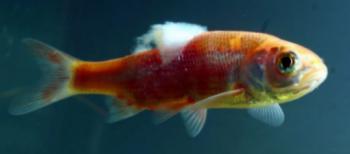| Back to Back Issues Page |
 |
|
The Goldfish Gazette, Issue #049 -- Fungal Diseases January 30, 2018 |
Goldfish Care Tips and GuidelinesA Free Monthly Resource For Goldfish Enthusiasts In This Issue
Fungal attacks on Goldfish are common. Fungal Diseases Following on from the two earlier Gazettes covering parasites and bacterial diseases, the last area I want to cover is fungal diseases. As explained earlier, often these conditions are inter-related. A parasitic infestation will often allow bacteria to invade the fish through damaged skin. Just as easily, fungal diseases can also invade the damaged area. Fungal infections usually appear as tufts of fuzzy white cotton wool like material on the body or fins of affected fish, but Columnaris bacterial infections and Epistylis parasitic infections look very similar, so visual diagnosis is unreliable without a microscope. Having said that, Epistylis is fairly rare in Goldfish, and if the fungus is on the body or fins, and not around the mouth area, you can be fairly certain it is fungus. Fungal TypesThe most common types are Saprolegnia which invades the skin, and Branchiomyces which affects gill tissue.Saprolegnia species and similar external fungal infections generally occur for two reasons: 1. The fish's immune system is weakened by rough handling, being chilled or excessively stressed. To develop this level of infection, Goldfish have had to be so poorly treated, their immune system is almost totally gone. 2. Localized damage. The fungal infection is restricted to the damaged area only, and the fish is energetic and eating normally. Branchiomyces is an aggressive fungus that will kill fish by destroying their gill tissue. This causes affected areas to die and slough off leaving gaping holes in the gill filament tissue. Branchiomyces requires high organic loads, high nitrate levels, crowding and high water temperatures to spread and kill fish, everything we shouldn’t be subjecting our fish to. Summer is the ideal time for this fungus type to appear with its higher water temperatures and greater food volumes. TreatmentsBefore starting any treatments, move the fish into pristine water. Add un-iodized salt to make a 0.3% solution, (3-4 grams per liter or one tablespoon per US gallon).Fish with Saprolegnia that are energetic and eating and have localized infection can be swabbed with methylene blue, malachite green or potassium permanganate paste on the infected area. Leave the fish in the salt bath until there is evidence the wound is healing. Fish with a more extensive infection and are lethargic need to have methylene blue or potassium permanganate added to the water. These fish do better in warmer water, around 78oF (26oC). This treatment is not an overnight cure and it can take weeks for a full cure. The first sign of improvement is when the fish becomes more active, and is eating normally. When healing is well advanced the fungus will slough off the fish in one piece and fall to the bottom. Give the fish another week in the sickbay, slowly reducing the medication. Branchiomyces infections are treated with formalin at 2 milliliters per 10 US gallons of water for exactly two hours followed by a 75% water change. Use methanol free formalin. If your fish is weak, halve the dose. Closely observe your fish during treatment and if it gasps at the surface, stop the treatment immediately. As formalin consumes oxygen from water, always aerate when using formalin to treat diseases. Don’t use formalin in water over 80oF (27oC) for the same reason. Because of gill damage, keep the water as cool as possible to increase the oxygen level, and slow the disease spread. All chemicals used to treat fungal diseases will destroy the bacterial action of a filter, so daily partial water changes of the sickbay are vital as no filter can be installed. In Summary Fungal infections are the result of either trauma, or poor fish care. In either case, they can be easily treated. To read more about fungal treatments, click here…
Green Water UpdateIt's now 13 weeks since starting the second Splosht test, and I still haven't got a clear pond.This will be my last update unless something dramatic happens to the water condition. I used the last treatment sachet two weeks ago. The water has changed from a milky brown to a translucent brown. I can see the filters and outlines of fish on the bottom, so it has definitely got clearer, but not crystal clear, nor in the 4 weeks claimed. Comments? Ideas? Feedback? I'd love to hear from you. Just reply to this e-zine and tell me what you think, or what topics you want covered. Next Month's Topic Water Qualitywww.facebook.com/aboutgoldfish |
| Back to Back Issues Page |